Plan all you want. But once that project or business plan is being executed, you’ll need a gap analysis to assess whether you’re meeting the requirements or you could be in trouble. As its name suggests, the gap analysis is a method to look at where you are and where you want to be. Between those two points is the gap you have to close. A gap analysis can be used in projects or for an organization to meet its targets.
It’s important to analyze whether your progress is at a pace to meet your objective or if you need to make adjustments to bridge that performance gap. Let’s learn more about how gap analysis can help your business.
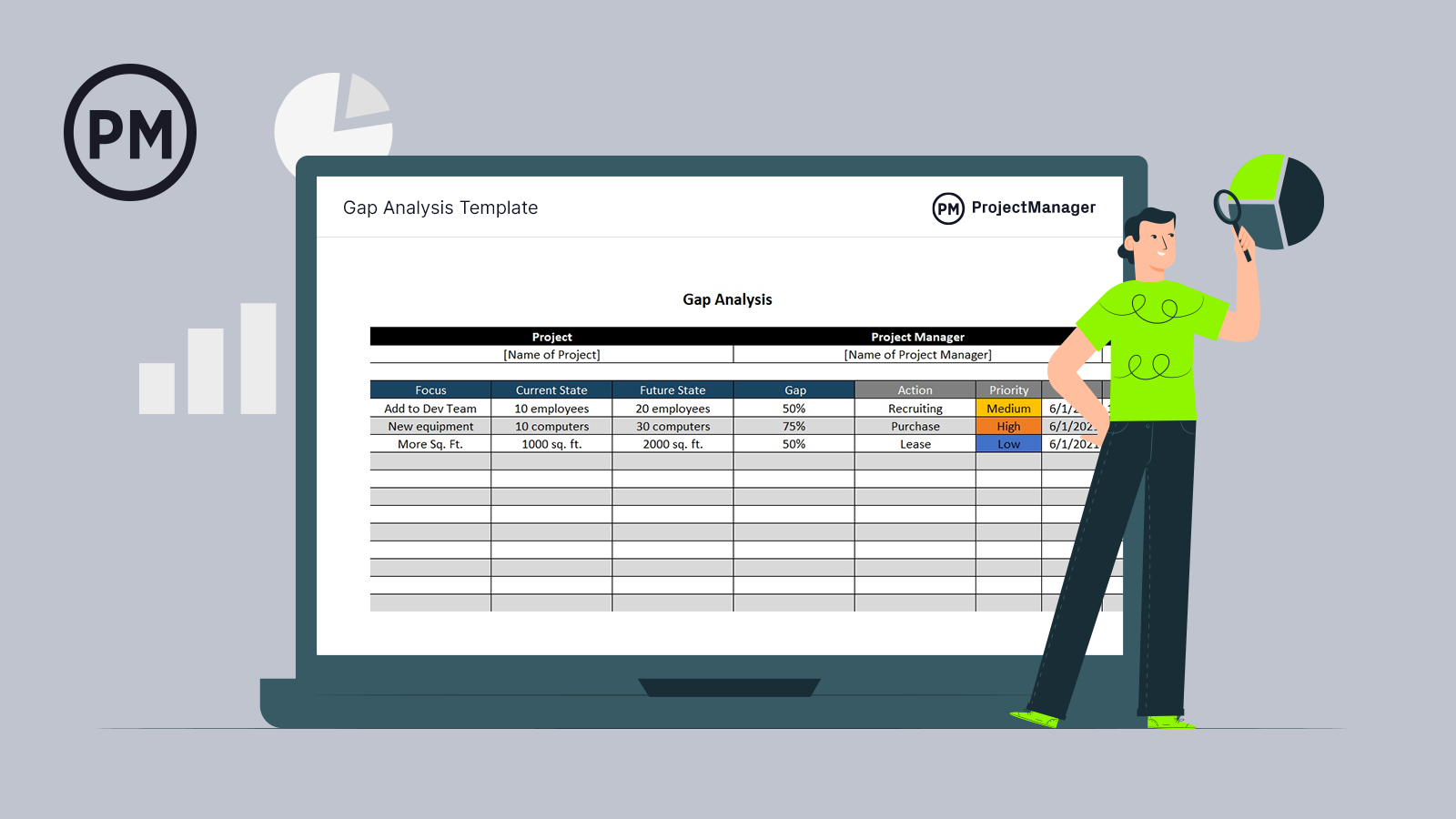
Get your free
Gap Analysis Template
Use this free Gap Analysis Template for Excel to manage your projects better.
What Is Gap Analysis?
Gap analysis is a formal study of how a business or project is currently progressing and where it plans to go in the future. Various perspectives can be analyzed, from business direction to business processes, from information technology to product management.
When talking about management, gap analysis is a means to compare a current state with a future state in terms of performance. Factors that impact performance include resource planning, capital investment, technology, etc. What a gap analysis does is identify the gaps between the optimized allocation and integration of resources to the current allocation level.
It’s by doing such measurements that a pathway towards improvements can be cleared. To do this involves determining, documenting and improving the difference between requirements and capabilities at the current time. Real-time data is going to improve how you understand the progress of your project.
ProjectManager is online work and project management software that helps with gap analysis by using live project data. Our real-time dashboard requires no setup and automatically collects live data, crunches the numbers and displays six project metrics in colorful graphs and charts. Get started with your gap analysis today for free with ProjectManager.
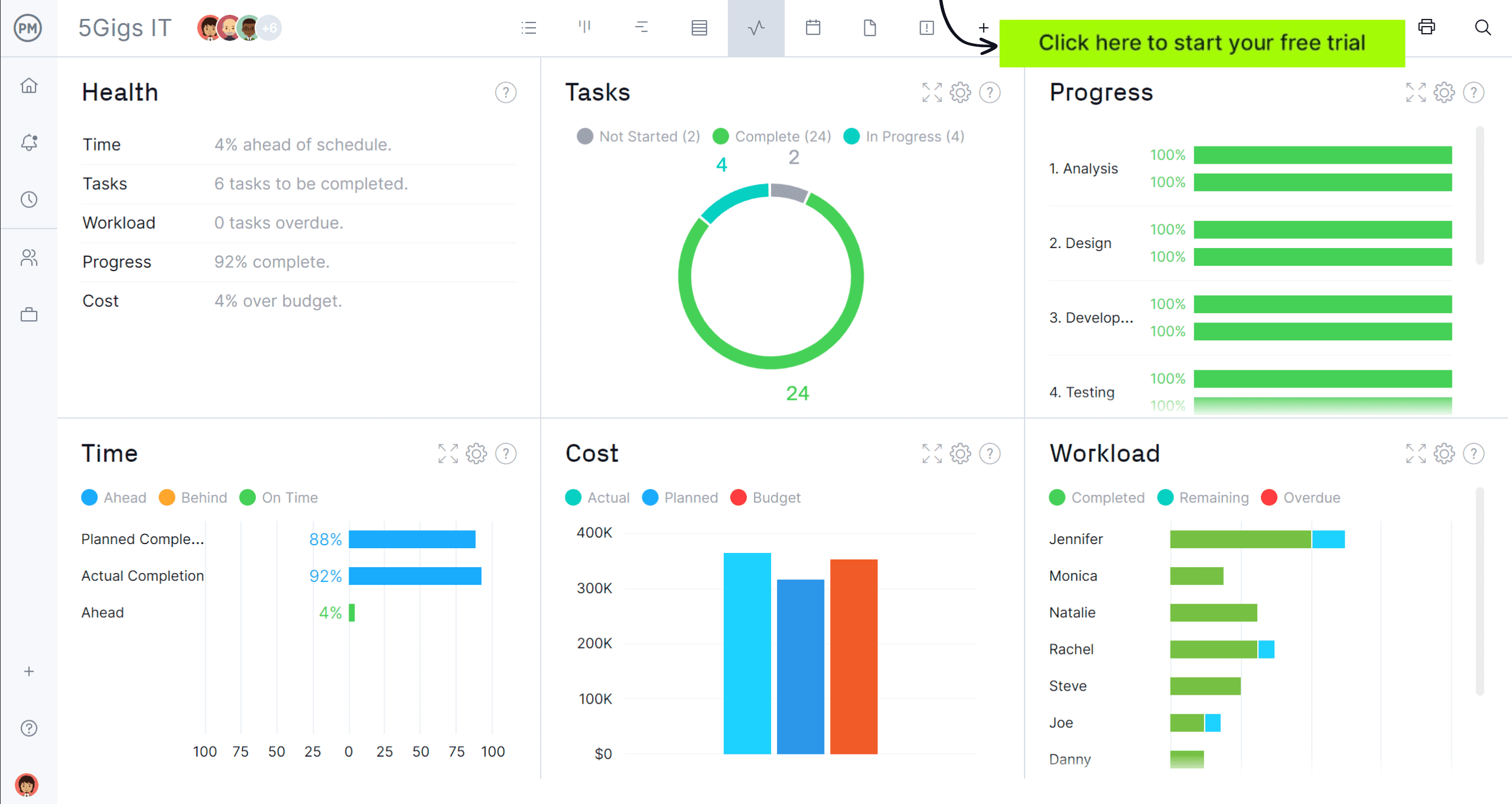
How to Conduct a Gap Analysis in 4 Steps
When you’re doing a gap analysis, you’re asking yourself a few questions: Where are we now, where do we wish we were and how are we going to get there? So, it’s not merely a picture but a roadmap to improve production.
There are four basic steps that you take when conducting a gap analysis. They can be boiled down to the following.
1. Identify Current State
The first step is knowing where you are at present. So, be clear as to what is being described and what is not. This will avoid scope creep and keep your analysis focused. Then comes collecting contextual information. That means collecting qualitative information, such as what your team processes and methodologies.
Also, quantitative information is important, meaning anything that can be counted and measured. That includes everything you’re currently doing. Yes, it’s a lot of data to gather, but the more you gather, the sharper the picture of your current state.
2. Define the Desired Future State
The point of a gap analysis is to figure out where you want to go and if you’re getting there. This is the desired state, future target or stretch goal. To get there you need to know about your current state and what a reasonable timeframe is to get from there to the goal you’ve set for yourself.
But first, you must mark that point in the future that you’re aiming for. Think about where that should be, what’s not happening that needs to happen, what could be happening that hasn’t before or has changed, and what needs to happen to get there.
3. Prepare a Gap Analysis Report
A gap analysis report involves systematically assessing the differences between current performance and desired outcomes within a project or organization. To do this involves several steps, which are outlined below.
Executive Summary
The executive summary in a gap analysis report is a concise overview of the key findings, conclusions and recommendations for the analysis. It is at the top of the gap analysis, though it is usually written last once the main body is completed.
Gap Analysis Objectives & Methodology
The objectives of gap analysis are to identify performance gaps, understand underlying causes, prioritize areas of improvement, develop an action plan and support continuous improvement. Methodologies for conducting a gap analysis include defining the scope and objectives, gathering data on the current state, defining the desired state, identifying the gap between the two and the root cause of it, then recommending actions based on the root cause analysis and monitoring as those plans are executed.
Gap Identification
Gap identification begins with comparing the current state with the desired state to find discrepancies. This can be done with a SWOT analysis, fishbone diagrams and process mapping to visualize inefficiencies.
Root Cause Analysis
You know where you are and where you want to go, but now it’s time to identify the reasons why there are gaps, which will help the organization prepare an action plan to close them.
A root cause analysis helps figure out why there is a gap. To do that you need to be very specific about the gap. Also, dig deeper and determine why the gap happened. Ask yourself questions that apply to your business and answer them honestly.
Action Plan
Action planning creates a detailed plan that includes specific steps to be taken, who is responsible for each action, a timeline for implementation and metrics to measure the success of the plan.
Resource Plan
Executing the action plan requires resources, which are the people, places and things needed to complete the tasks. These resources must be allocated so that the right amount is available at the right time.
Risk Assessment
A risk assessment helps identify, evaluate and prioritize risks associated with the gaps between the current and desired outcomes. Using a risk assessment in gap analysis helps to understand the discrepancy and implications of those discrepancies on operations, objectives and overall strategy.
4. Bridge the Gap
You’ve done the due diligence, and now it’s time to act. You know why there’s a gap, so you must now devise a way to close it. To do this, you can follow the guidelines of basing all improvements on the information you discovered when you identified the gap. Also, consider the cost of implementation for each solution that you come up with; you might not have the capital or capacity to achieve it. Finally, figure out the date at which the gap will be closed. If you don’t have a deadline, it will get overlooked or ignored.
After doing all the work, don’t neglect the follow-through. That is, follow up on the improvements you’re making by doing a gap analysis. If you don’t, then you’re doomed to repeat them. Also, it’s important not to try and close too many gaps at once. If you put too much stress on any organization, it’s going to break.
Gap Analysis Template
Manage the process with our free gap analysis template for Excel. It will help you meet the business targets that have been set for your project and streamline that process. You can add the current item stage and the future item state. Then use our dropdown menu to note the gap percentage. There are even action steps, assignments and statuses. But other templates fill out those steps.

Gap Analysis Example
Let’s examine gap analysis by creating a hypothetical gap analysis example. For instance, let’s say Company X has developed Widget and has gone to market and it wants to do a gap analysis on the deviations from its sales objectives of this new product launch and make the required improvements.
- First, they have to gather market data and do customer surveys to discern what the problem is that prevents Company X from selling the number of Widgets they forecasted.
- Next, comes the analysis of that data and the current state of the sales problems.
- From there, Company X will figure out the future state it hopes to reach in terms of Widget sales.
- With these two points mapped out, Company X can now calculate the gap percentage.
- This information will drive the action steps necessary for the company to achieve its target, which might include adding to its sales force, further investment in marketing or even changes to the product.
- Once the action plan is set up, Company X will implement and monitor its progress as it bridges the identified gap.
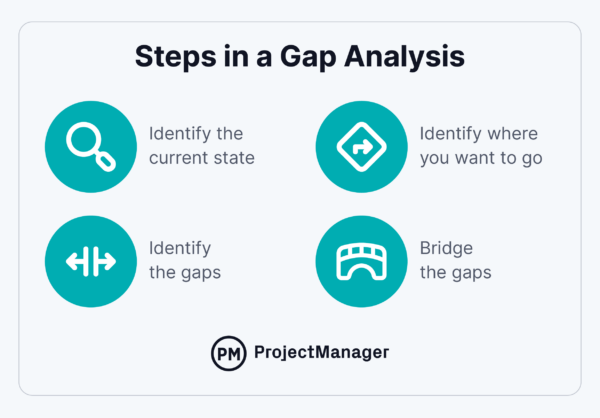
Types of Gap Analysis
What gap analysis is doing is providing a way to measure the investment in time, money and human resources that are needed to achieve an outcome. There are several different gaps and outcomes that gap analysis can target.
Market Gap Analysis
Gap analysis can help identify gaps in the market. A market gap analysis or marketing gap analysis consists of using market research tools and techniques to identify “market gaps” which are discrepancies caused by an insufficient or unfit offer of products that aren’t satisfying the needs of the customers for a variety of reasons, which results in underserved market segments.
Some of the main causes for market gaps are:
- Existing products don’t offer the features that are perceived as valuable for customers, known as a product gap
- Emerging trends such as new technologies, regulations, economic factors and changing customer behaviors can open up a gap in the market
- Growth of the total addressable market for a product or brand causes a marketing gap as the current businesses serving a market are not able to meet demand
- Usage gap, which is the gap between the total potential for the market and the actual use of the product or in other words, its present market share. This includes data, such as market use and existing use.
Strategic Gap Analysis
A systemic process to assess the differences between the current performance and desired strategic goals. It helps to identify areas for improvement and develop actionable plans to align activities with long-term objectives.
Process Gap Analysis
This method is used to evaluate the differences between the current state of a specific business process and its desired or optimal state. It helps organizations identify inefficiencies, redundancies or areas for improvement within their processes.
Performance Gap Analysis
A performance gap analysis assesses the difference between actual performance and desired performance in an organization. It helps improve performance where needed and facilitates targeted actions to enhance overall performance.
Skills Gap Analysis
This process identifies the difference between the current skills of employees and the skills needed to meet the organization’s objectives. It assesses workforce capabilities and plans training and development initiatives to ensure that the right talent to achieve goals is in place.
Product Gap Analysis
Gap analysis can also target a product gap which measures how well a product meets its targeted need. A product gap analysis is the discrepancy between the features of a product and the product features that are perceived as valuable for target customers.
This is caused by a lack of understanding of the customer needs, likely caused by poor market research, lack of proof of concept, omissions in the product development process or maybe certain customers just don’t align with your company’s mission statement or general policy.
In some cases, it might be caused by outdated product technology or functionality issues that make potential customers choose other alternatives in the market. Product gaps can be solved through techniques such as value stream mapping, benchmarking or agile product development.

Gap Analysis Tools
There are gap analysis tools that can help a project manager identify the gap between the current state of the project and its future goals and objectives. These tools will also help to make clear the required tasks that are necessary to close that gap.
SWOT
One such tool is a SWOT analysis, which is an acronym for strengths, weaknesses, opportunities and threats. By using a SWOT analysis both quantitatively and qualitatively, you can determine internal and external threats to the project.
Fishbone Diagram
Another tool is the fishbone diagram, which is also called a cause-and-effect diagram. It is a way to visualize and categorize the potential causes of a problem. Then you can go about identifying its root causes. It’s a helpful tool when brainstorming to keep the conversation focused.
McKinsey 7-S Framework
The McKinsey 7-S Framework can be used to improve performance, examine the effects of future change, align departments and processes and determine how best to implement a proposed strategy. It can be applied to teams or a project by looking at the seven interdependent factors of the tool.
PEST Analysis
One more tool is the PEST analysis, which is another acronym that stands for political, economic, social and technological. This allows one to make a framework of macro-environmental factors to design effective environmental strategies, which would apply to applicable projects.
More Free Templates For Better Gap Analysis
Gap analysis requires collecting and analyzing data. But that’s only the start. Next, you have to create a plan to act on what you’ve learned and then monitor the progress of that plan to make sure you’re meeting your milestones. Project management software can do all this and more but if you’re not ready to take that leap then you can use these free templates for gap analysis project management.
Action Items Template
The action items you sketched out in the gap analysis template can be fully realized in this free action items template for Excel. It provides the who, what and when for the plan, like a to-do list but more robust. You can list all the action items, assign them to your team, set the priority to help organize what gets done when add directions and even show the status of the work. But for greater detail on progress and performance, there’s our next free template.
Project Dashboard Template
You’re going to want to monitor your action plan as you execute it. Our free project dashboard template for Excel can help you track time on tasks, cost and workload. Unlike with project management software, though, you’re going to have to do all the inputting yourself, but it’s worth the effort to help stay on schedule. This free template can also be used to gather data on your gap analysis, so we’ve come full circle.
Progress Report Template
Don’t forget to keep your stakeholders updated on your progress in closing the gap. Use our free progress report template for Word. It’s a document that captures where you are in the project to update stakeholders and manage their expectations. You get a section in which to summarize the project scope, schedule, cost and any risks. Then you can dig down deeper into individual tasks and their status.
How ProjectManager Helps With Gap Analysis
ProjectManager is online work and project management software that can help you close the gap in your gap analysis. Our tool organizes your action plan into tasks on a timeline that can be assigned and monitored while reporting back to stakeholders on the progress of your objective to meet that gap target.
Gantt Charts for In-Depth Planning
Use our interactive Gantt chart to map your plan on a visual timeline that links dependent tasks to avoid bottlenecks later in the project. Gantt charts are essential project management tools that set milestones and much more. But unlike other Gantts, ours can filter for the critical path without any complex calculations and then set a baseline to see planned effort against your actual effort once the project is executed. That helps you stay on schedule.
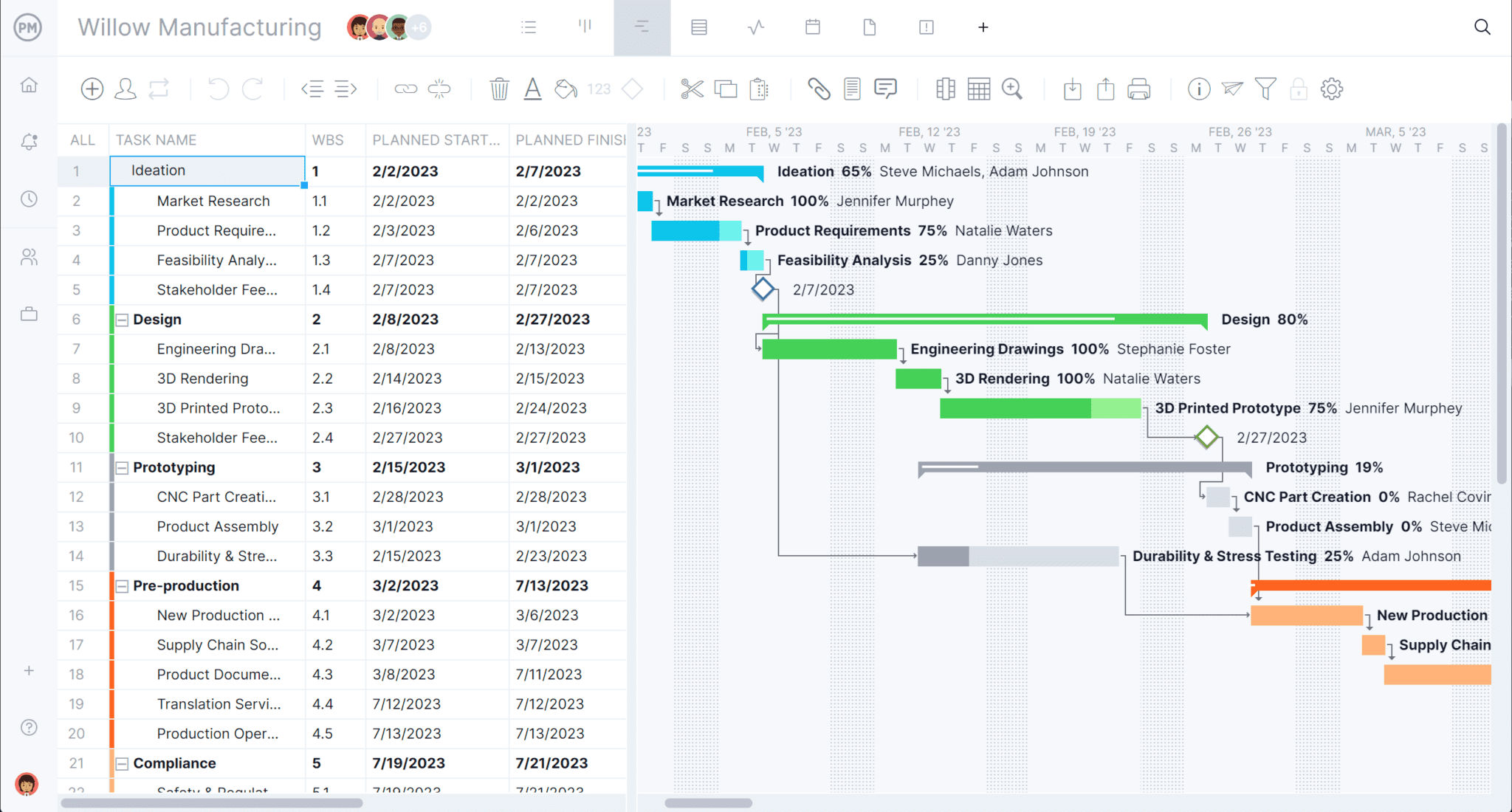
Multiple Views to Execute Work How You Want
Once the project is in the hands of your team they might not want to use a planning-intensive tool, such as the Gantt. Our software has multiple project views that share data in real time so teams can work how they want. Robust task lists show everything from priority to status while the visual workflow of a kanban board fosters collaboration on sprints and allows teams to manage their backlog.

Report on Progress in Minutes
No one is more invested in the success of your plan to close the gap in your gap analysis than the stakeholders of the project. Project managers must manage their expectations in order to do their jobs. Our one-click reports are completely filterable to show only the data stakeholders need to see and then they’re easy to share how stakeholders want, as PDF attachments or even printed out. Keep stakeholders updated and keep your focus on the project.
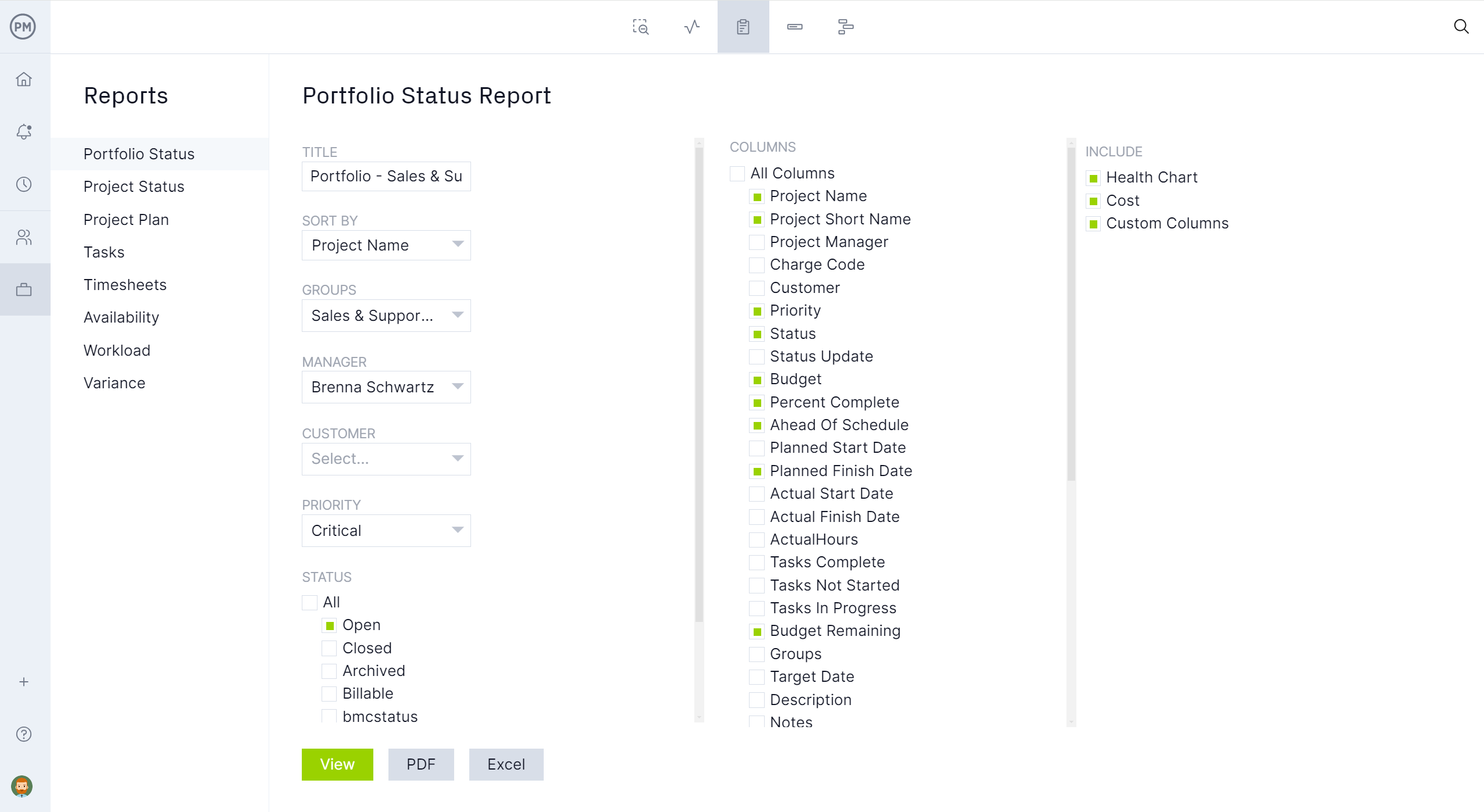
Managers get transparency into their team’s process and teams are given a collaborative platform that helps them work better together with task-level commenting and file sharing. Automated workflows and task approvals give managers control and email and in-app notifications keep everyone on the same page. Mind the gap and meet your objectives with ProjectManager.
Gap analysis is a great tool to help make better decisions. ProjectManager is online project management software that allows you to implement those decisions more effectively with real-time data and online Gantt charts. See how it can help you bridge the gap by taking this free 30-day trial today.

